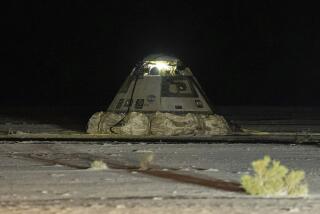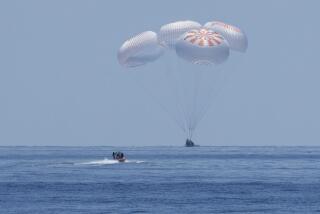Shuttle Columbia on Course for Desert Landing Monday : NASA: It’s the last scheduled spacecraft touchdown at Edwards Air Force Base through the end of 1994.
EDWARDS AIR FORCE BASE — Calling all shuttle watchers: Monday is it.
The last scheduled Southern California shuttle landing--for at least 14 months--is planned for early Monday at Edwards Air Force Base.
Because of road construction in the usual public viewing area, spectators will be able to watch the shuttle Columbia’s landing from NASA’s hillside viewing site. It’s an area normally reserved for the space agency’s invited guests, offering a closer, elevated vantage point to witness the orbiter making its descent.
Columbia will announce its return to Earth after a 14-day life sciences mission with its characteristic double sonic boom moments before its planned 7:08 a.m. landing in the California desert.
It is the last scheduled landing through the end of 1994, NASA spokesman Don Nolan said. All nine shuttle missions planned for 1994 are scheduled to land at Kennedy Space Center. The Florida landings save NASA an estimated $1 million per mission.
“Not only do you have the expense of sending the orbiter back on the (modified) 747, but a lot of people travel out from Kennedy,” Nolan said. “It’s definitely much cheaper if they can land it there. NASA’s trying to reduce costs just like everybody else is.”
NASA’s Dryden Flight Research Facility is estimating that between 10,000 and 15,000 people will be on hand to see Columbia’s landing.
“It’s very difficult to estimate,” Nolan said. “It’s a weekday, but it’s the last (landing) for a while so we don’t know how many people will attend.”
The last scheduled shuttle landing that occurred at Edwards--May 16, 1992--drew an estimated 125,000 people, Nolan said. That landing, however, was the first of NASA’s newest orbiter, Endeavour. It was also on a weekend day.
“The place just exploded (with people),” he said. “It was fun.”
Since the maiden Endeavour voyage ended at this military base on the edge of the Mojave Desert nearly 18 months ago, there have been just two shuttle landings at Edwards. Both were diverted shortly before their planned landing from Florida’s Kennedy Space Center because of poor weather conditions.
About the only people who witnessed the unscheduled landings, one last December and the most recent in May, were NASA and Edwards personnel. Members of the public who happened to be touring either the base or the Dryden facility the day of an unscheduled landing also got an unexpected surprise.
The largest crowd ever to witness a shuttle landing at Edwards was more than a decade ago, Nolan said. About 545,000 were on hand for a July 4, 1982, shuttle landing attended by then-President Ronald Reagan and his wife, Nancy.
In October, 1988, there were 420,000 spectators to watch Discovery touch down at Edwards. It was the first shuttle mission after the 1986 explosion of Challenger.
A March, 1989, landing of Discovery drew about 460,000 people, Nolan said, noting that the large crowd was attributed to the orbiter’s weekend landing date.
Columbia’s Monday landing, which will bring to an end the longest shuttle mission ever, will be the 58th shuttle landing. Since the first shuttle orbited the Earth in 1981, there have been 38 landings at Edwards, Nolan said. Shuttles have landed 18 times at Kennedy Space Center and there has been one landing in New Mexico.
Edwards will be open to shuttle watchers in self-contained RVs 24 hours before the shuttle landing, according to a base spokesman. Spectators in other vehicles will be allowed on the base 12 hours before the landing.
It is recommended that viewers arrive at least two hours before the scheduled landing time.
“We don’t want people to be stuck in traffic when it lands,” Nolan said.
Recorded information on the shuttle landing is available by calling (805) 258-3520.
* RESEARCH: First animal dissections in space. B5
More to Read
Sign up for Essential California
The most important California stories and recommendations in your inbox every morning.
You may occasionally receive promotional content from the Los Angeles Times.










